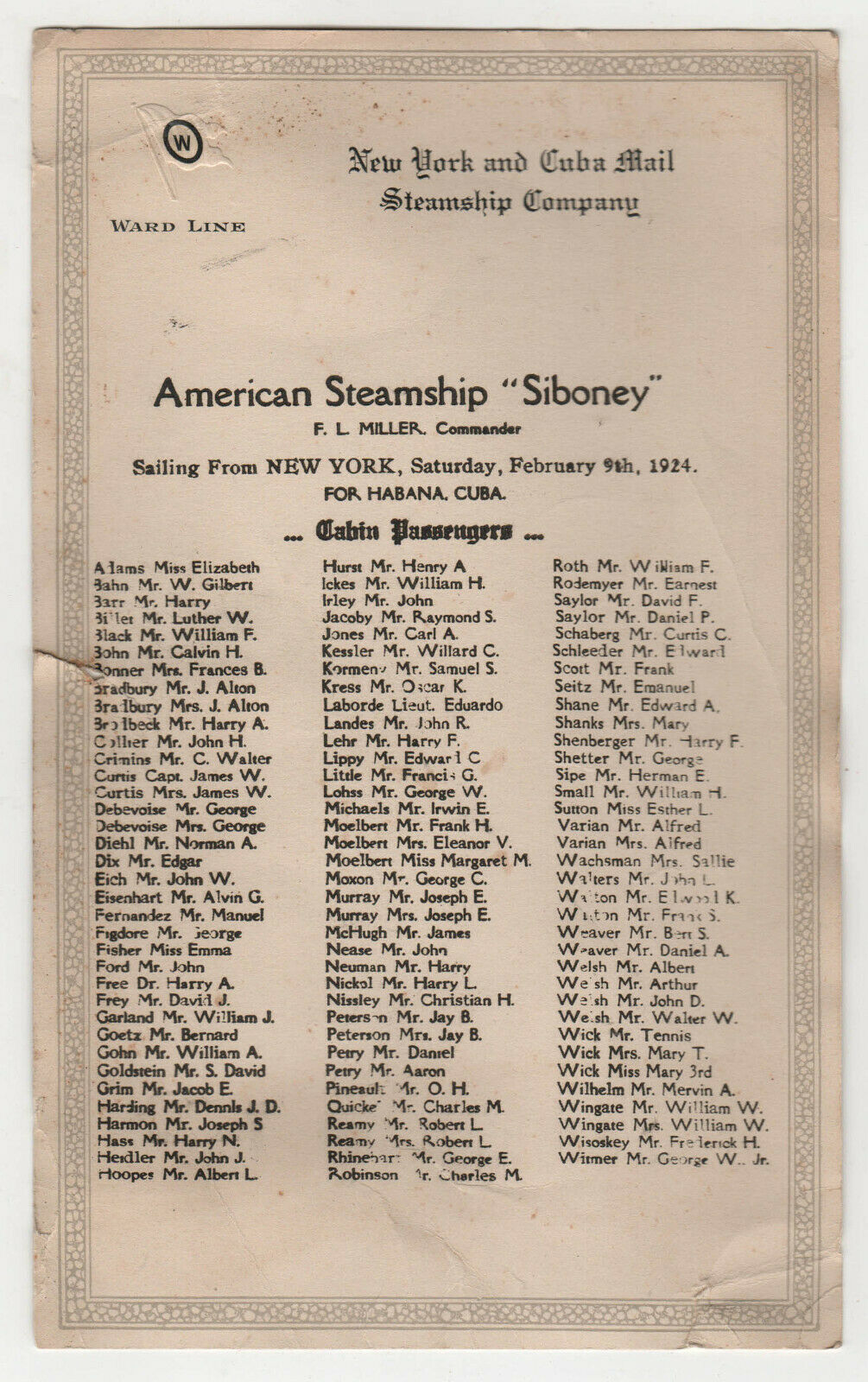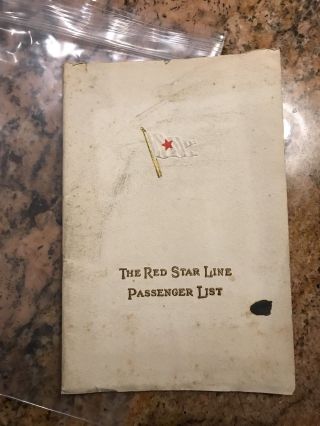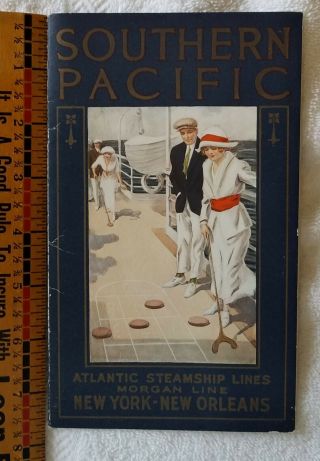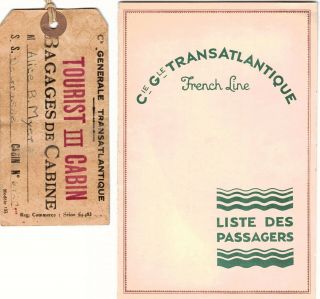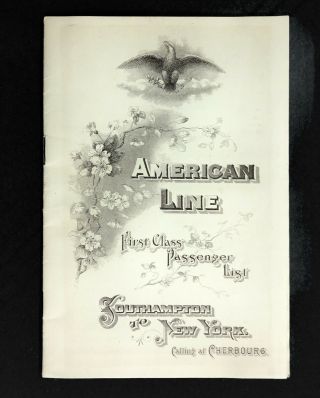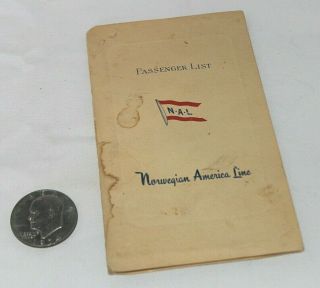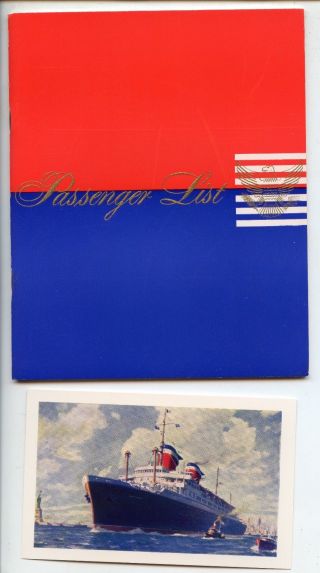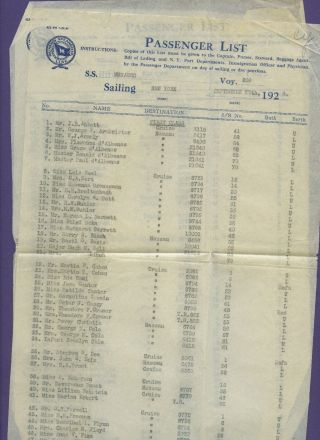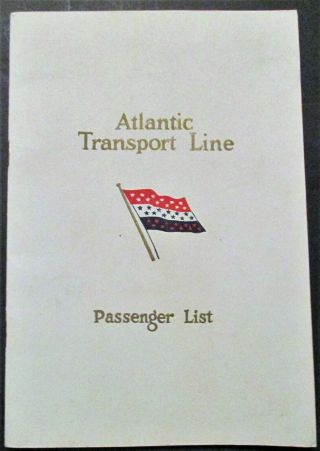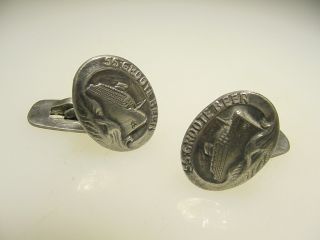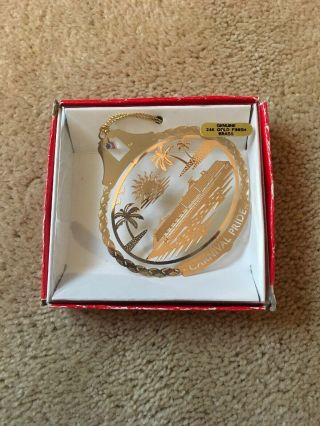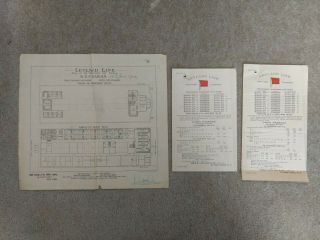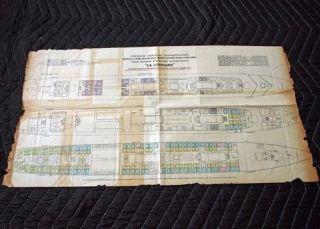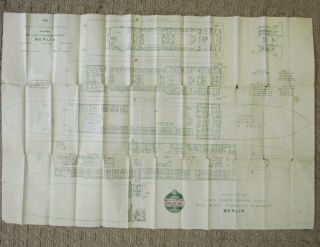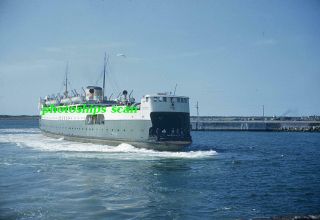1924 WARD LINE SS Siboney USS Passenger List YORK HAVANA Cuba Mail Steamship
Item History & Price
| Reference Number: Avaluer:17397463 | Type: Passenger List |
| Featured Refinements: Steamship |
Atlantic, Gulf & West Indies Steamship Lines (AGWI) advertisement 1921 showing four component lines.In 1907 Consolidated Steamship Lines, a shipping conglomerate of Charles W. Morse, bought the Ward Line for a large sum. When that company went bankrupt the following year, the former subsidiaries of Consolidated, including the Ward Line, joined forces to form the Atlantic, Gulf & West Indies Lines (Agwilines) holding company. Common resources were pooled, but each company maintained its own management.During World War I, two of its newest liners, SS Havana and SS Saratoga, and two new liners under construction, SS Siboney and SS Orizaba, were requisitioned for government use. Saratoga and Havana became United States Navy hospital ships Comfort and Mercy, respectively; Sibony and Orizaba became troop transports under their original names. All but Saratoga/Mercy eventually returned to the line after the war.In the 1920s, service reductions, poor management, and rehabilitation of its aging fleet nearly bankrupted the company, but subsidies from the United States government helped to resuscitate the company. In 1929 government financing help the Ward Line build two new luxury liners, SS Morro Castle and SS Oriente. With two of the newest liners in the Merchant Marine and relatively low fares, the company was able to weather the early years of the Great Depression relatively well.In 1934, the Ward Line's reputation for safety at sea suffered a major setback. On September 8, 1934, Morro Castle caught fire killing 137, a tally that is still the highest death toll of any U.S.-flagged merchant ship. In the months that followed the company suffered a series of further public relations disasters. Havana ran aground near the Bahamas in January 1935, and SS Mohawk a ship chartered by the Ward Line to replace Havana, sank on its initial voyage the same month. The Ward Line name was dropped in favor of Cuba Mail Line to help put these disasters behind the company, but it never truly recovered.In 1942 all of the company's remaining passenger liners were requisitioned by the government for use during World War II, none of which were returned to the company. In 1947, Agwilines resurrected the Ward Line name for limited passenger service on converted World War II freighters. This reduced service lasted until 1954, when Agwilines was liquidated as a result of rising fuel prices and competition from airlines.
Later incarnationsIn 1955, the Ward Line name was purchased by Thomas Stevenson who operated foreign-flagged freighters under the Stevenson Lines name, but as Stevenson's company diversified, it moved away from the shipping industry. In 1955, Companñía Naviera García, a Cuban steamship company, bought the Ward name and ran its company under the name Ward-García Line. Ward-García lasted only until 1959 when declining demand and the Cuban Revolution ended its service.
List of shipsPassenger steamships of the Ward Line: SS City of Washington (1877)
SS Niagara (1877)
SS Saratoga (1877)
SS City of Alexandria (1879)
SS Santiago (1879)
SS Saratoga (1879)
SS Newport (1880)
SS Cinfuegos (1883)
SS Seneca (1884)
SS Orizaba (1889)
SS Seguranca (1889)
SS Yumuri (1889)
SS Vigilancia (1890)
SS Yucatan (1890)
SS Valencia (1897) – Chartered from the Red D Line.[1]
SS Havana (1898)
SS Mexico (1898)
SS Morro Castle (1900)
SS Esperanza (1901)
SS Monterey (1901)
SS Yucatan (1903)
SS Havana (1906)
SS Merida (1906)
SS Mexico (1906)
SS Saratoga (1907)
SS Orizaba (1917)
SS Siboney (1918)
SS Morro Castle (1930)
SS Oriente (1930)
SS Mexico (1933)
SS Monterey (1933)
SS Agwiprince (1941)[2]USS Siboney (ID-2999) was a ship transport for the United States Navy during World War I. She was the sister ship of USS Orizaba (ID-1536) but neither was part of a ship class. Launched as SS Oriente, she was soon renamed after Siboney, Cuba, a landing site of United States forces during the Spanish–American War. After her navy service ended, she was SS Siboney for the New York & Cuba Mail Steamship Co. (commonly called the Ward Line).[note 1] The ship was operated under charter by American Export Lines beginning in late 1940. During World War II she served the U.S. Army as transport USAT Siboney and as hospital ship USAHS Charles A. Stafford.As a transport during World War I, Siboney made 17 transatlantic voyages for the navy carrying troops to and from Europe, and had the shortest average in-port turnaround time of all navy transports. During her maiden voyage, her steering gear malfunctioned which resulted in a collision between two other troopships in the convoy.After her World War I service ended, Siboney was returned to the Ward Line and placed in New York–Cuba–Spain transatlantic service; the liner ran aground at Vigo, Spain in September 1920. Despite considerable damage, she was repaired and placed back in service. In late 1921, Siboney was switched to New York–Cuba–Mexico routes, which were a popular and inexpensive way for Americans to escape Prohibition. In late 1940, she was chartered to American Export Lines to return Americans fleeing Europe at the outset of World War II, making seven roundtrips from Jersey City, New Jersey, to Lisbon.During World War II, Siboney was requisitioned by the War Shipping Administration (WSA) and assigned to the War Department as a U.S. Army transport. She made several transatlantic trips and called at ports in Africa, the Middle East, Canada, the Caribbean, and the United Kingdom. During a 1944 overhaul, the ship was selected for conversion to a hospital ship. Renamed USAHS Charles A. Stafford after a U.S. Army doctor killed in action in Australia, the ship served in both the European and the Pacific Theatres. After the end of her army service, the ship was laid up in the National Defense Reserve Fleet in February 1948, and sold for scrapping in 1957.SS Oriente was a combination cargo and passenger vessel built by William Cramp & Sons, Philadelphia, for the Ward Line. In mid-1917 the United States Shipping Board (USSB) commandeered and received title to all private shipbuilding projects in progress, including the still-incomplete Oriente and her sister ship Orizaba. Plans for both ships were modified for troop carrying duties.[5] Oriente was launched on 15 August 1917, renamed Siboney on 28 February 1918, delivered to the navy on 8 April, and commissioned the same day, Commander A.T. Graham in command.[6]
The first of two lifeboats from the torpedoed British transport SS Dwinsk to be rescued by Siboney on 21 June 1918Siboney sailed from Philadelphia on 16 April as a unit of the Cruiser and Transport Force, and arrived at Newport News two days later to embark her first contingent of troops. She departed Hampton Roads on 23 April and joined her first convoy the following day. On 25 April, her rudder jammed; and, in the ensuing confusion, transports Aeolus and Huron collided and had to return to New York. On 4 May, the convoy was joined by the war zone escort of eight destroyers and, on 6 May, Siboney arrived at Brest. Debarking her troops, she sailed the following day and arrived at Hoboken, New Jersey, on 15 May.[6]Siboney embarked her second contingent of troops at Lambert's Point, Virginia, on 25 May and sailed the following day. The New York section of the convoy joined two days later and the ships entered the war zone on 6 June. In French waters, they were met by USS Corsair, a squadron of minesweepers, an American dirigible, and two French hydroplanes. Siboney arrived in Bordeaux on 8 June and departed the following day but remained anchored in the mouth of the Gironde until 13 June, awaiting the tanker Woonsocket. On 15 June, the convoy passed six empty lifeboats from the torpedoed transport USS President Lincoln. Siboney entered the American war zone on 20 June, and the next day rescued survivors of the British vessel, SS Dwinsk, which had been torpedoed three days previously. The transport arrived at New York on 22 June and anchored in the North River.[6]Siboney sailed for France on 30 June; after delivering her troops at Brest on 12 July, she returned to New York on 25 July. She sailed again on 31 July. Before arriving at Brest on 12 August, she had to maneuver several times to evade possible submarine contacts. She arrived at New York on 22 August and was given a two-week repair period.[6]On 4 September, Siboney sailed from New York on her fifth crossing and arrived at Saint-Nazaire nine days later. On 15 September, she embarked a number of wounded troops and left Saint-Nazaire the same day, but, due to heavy submarine activity, swung at anchor for several days before her convoy sailed. She arrived on 29 September at New York. On her sixth eastward crossing, between 6 and 15 October, an influenza epidemic broke out among the troops, killing a number of soldiers. Sailing from Brest on 16 October, the transport returned to New York on 24 October.[6]Siboney had already embarked troops for her next voyage when, on 3 November, she was ordered to disembark them. She sailed the following day with an army brigadier general and his staff, and a naval draft of 500 men. She arrived at Saint-Nazaire on the 12 November, shortly after the announcement of the Armistice, and was met by a cheering crowd.[6]
Siboney arrives in New York Harbor in late 1918 or 1919 with returning soldiers crowding the rails.Siboney then began her peacetime mission of returning American veterans from Europe to the United States. After embarking 513 wounded men at Saint-Nazaire, she moved to Brest on the 15th and took on 600 more passengers. She sailed the same day under escort and reached New York on 24 November. During the next ten months, Siboney made ten more round trips between the United States and France, returning over 3, 000 troops per trip when fully loaded.[6] On one such return trip in August 1919, Siboney carried Admiral Henry T. Mayo and Congressman Thomas S. Butler home from France.[7]Siboney returned to New York on 2 September at the conclusion of her 17th trip, having traveled over 115, 000 nautical miles (213, 000 km) and transported approximately 55, 000 military passengers to and from French ports.[6] According to the Statistical Department of the U.S. Navy, Siboney had the shortest average in-port turnaround time out of 37 U.S. Navy transports used during World War I. The ship completed 17 round trips and had an average turn-around time of just under 30 days per trip, almost ten days shorter than the average of 39.8 days.[8]On 10 September at Hoboken, Siboney was decommissioned and turned over to the War Department, who returned the ship to the Ward Line, her original owners.[6]
Interwar civilian serviceAfter her reacquisition, the Ward Line placed SS Siboney in transatlantic service on a New York to Havana, Tenerife, Bilbao, Santander, and Vigo route. On 9 September 1920, the ship ran aground in the harbor at Vigo.[9] Initial efforts to re-float her were unsuccessful, but by late October, Siboney had been repaired enough to make it to Shields.[10][11] Despite considerable damage, Siboney was refitted and placed in service again and, by March 1921, the Ward Line was advertising passage to Spain via Havana aboard her.[12][13] The Ward Line, however, abandoned the New York–Cuba–Spain service later in 1921 due to a lack of passengers.[14]By November 1921, Siboney was placed in New York–Cuba–Mexico service, where business thrived, in part because of Prohibition in the United States. Ward Line cruises to Havana were one of the quickest and least expensive ways to what one author called "alcohol-enriched vacations".[14] A typical route from this time period would sail from New York and call at Nassau, Havana, Progreso, Veracruz, and Tampico, skipping Nassau on the return.[15] Prohibition also had a more direct effect on Siboney and her crew. On 27 June 1922, Siboney — freshly returned from Havana with a load of pineapples — was raided by United States Customs Service inspectors who seized 300 bottles of smuggled liquor on board.[16] In December 1923, four boiler room workers were arrested when police became suspicious of a man who had apparently just delivered a supply of alcohol to the docked ship.[17]Siboney underwent a major refit in 1924 during which time she was replaced on her routes by SS Yucatán, formerly the North German Lloyd ship Prinz Waldemar.[12] After returning to service for the Ward Line, Siboney was the first to relay messages from Miami about the severity of the Great Miami Hurricane when she passed there shortly after the storm hit in September 1926.[18]On 18 February 1928, Siboney rammed and sank the coal barge Seneca off Ambrose Light during a snowstorm;[19] the barge had been cut down in 1915 from SS Seneca, coincidentally, a former Ward Line ship.[12] Bad luck continued for Siboney on 5 January 1929, when she rammed and sank the Bauer Towing Company tug Phillip Hoffman off the Battery, killing the tug's engineer.[20]Siboney continued her same routes into the 1930s, and by 1933 typical runs for Siboney were from New York to Havana, Progreso, and Veracruz and back, omitting Progreso on the return.[15] On one such return trip from Veracruz and Havana in April 1935, a passenger had $5, 000 worth of diamond and platinum jewelry stolen while on board.[2] By 1935, multiple public relations disasters for the Ward Line — the fire and sinking of Morro Castle off New Jersey in 1934 and the grounding of Havana and the sinking of Mohawk in the months that followed — caused the "Ward Line" name to be dropped in favor of the "Cuba Mail Line" moniker.[21] By 1939, Siboney, still on the New York–Cuba–Mexico route, sported a new paint scheme of "dove grey" hull and black funnels with white markings to reflect this change in name.[15][22] In late 1940, however, the struggling Cuba Mail Line chartered Siboney to American Export Lines which employed her on Jersey City–Lisbon service.[12][23] During her American Export service, one of her passengers to the U.S. was French aviator and writer Antoine de Saint Exupéry, when he immigrated in January 1941 to Asharoken, New York after Germany’s armistice with France.[24][25]On 12 April 1941 at 13:30, 320 nautical miles (590 km) out of Lisbon, the ship — painted with a large American flag and "American Export" lettering on each side — was accosted by "two submarine chasers flying British ensigns" that fired shots over Siboney's bow, one of which landed less than 100 feet (30 m) away from the ship. According to Siboney's captain, Wenzel Habel, the two ships were British corvette types marked "K-25" and "K-125" — which may have been Flower-class corvettes HMS Azalea (K25) and HMCS Kenogami (K125). After answering questions from "K-25" shouted via loudspeaker, Siboney was allowed to resume her course. Habel filed a protest with British officials when Siboney docked at Bermuda.[26]
World War II Army service
USAT Siboney in port, c. 1942–1943At the conclusion of her seventh and final journey for American Export, Siboney was placed under time charter for duty as an Army transport.[3][23] After a hasty outfitting, the redesignated USAT Siboney was put to work transporting troops. Based in New York, she made trips up and down the Atlantic and into the Caribbean, and, by the end of 1941, had called at Bermuda, San Juan, Trinidad, St. John's, Charleston, Newport News, Cristóbal, Jamaica, and Panama.[3]December 1941 saw Siboney depart from New York to Trinidad and on to Cape Town, then sailing up the east coast of Africa to Basra, Iraq, and Bandar Shahpur, Iran. The ship returned to Cape Town via Aden and underwent routine boiler repairs there, before returning to New York in April 1942. After undergoing six weeks of repairs at Bethlehem Steel Company, the transport sailed for Halifax, Iceland, and the Clyde, Scotland, in late May, returning to New York in July. Another trip to England and back followed in September 1942.[3]On 1 July 1942 the ship had been acquired by the War Shipping Administration (WSA) under a bareboat charter converting the Army's time charter to a sub bareboat charter. On 9 August 1943 WSA purchased the ship with the Army's bareboat charter continued.[27]In early December 1942 Siboney departed for Newfoundland but put into Halifax for two months of drydocking and repairs after she collided with SS City of Kimberly. After returning to New York in February 1943, she made several transatlantic runs, calling at Casablanca, Oran, Gibraltar, Clyde, Durban, Rio de Janeiro, Trinidad, and Cuba over the next 11 months. Siboney returned to New York for major repairs and reboilering at Bethlehem Steel Co. In January 1944, while undergoing this work, the ship was selected for conversion to a hospital ship.[3]
USAHS Charles A. Stafford, c. 1944–1946The ship was renamed USAHS Charles A. Stafford after Captain Charles A. Stafford of the U.S. Army Medical Corps, who was killed during the air raid on Broome, Western Australia, while participating in the evacuation of Java on 3 March 1942. With her conversion complete in September 1944, the Stafford, equipped with new boilers, a single stack in place of her original two, and other improvements, moved to her new homeport of Charleston.[4][28] From that port the ship made monthly runs to the United Kingdom and back until May 1945, interrupting the pattern only once for a trip to Gibraltar and Marseilles. Steaming to New York at the conclusion of her last transatlantic run, Charles A. Stafford was overhauled for duty in the South Pacific.[4]With the alterations complete, the veteran ship — now homeported at Los Angeles — sailed in August 1945 for Cristobál and on to Honolulu, Manila, Biak, Leyte, and Mindoro. After returning to Los Angeles in October, the Stafford sailed for Honolulu, Manila, and Eniwetok and back.[4]After sailing to her new homeport of New York via the Panama Canal during February 1946, Charles A. Stafford resumed her North Atlantic runs to the UK.[4]On 30 August 1946 the Army transferred the ship to the Maritime Commission. On 16 February 1948 the ship was placed in the James River Reserve Fleet. Kept on reserve under her original name of Siboney, the ship was sold by the Maritime Administration on 2 January 1957 for $286, 125 to Bethlehem Steel for scrapping.[27] _______________________________________________________________ Why Buy From Chestnut Hill Books? Chestnut Hill Books has a perfect 100% feedback rating dating over 18 years and spanning 20, 000+ transactions, with customers in all 50 states and over 100 countries on 6 continents. Our detailed seller ratings (item as described, communication, shipping time and shipping and handling charges) are among the best on eBay. All domestic purchases come with free shipping and complimentary delivery confirmation, trackable through the United States Post Office. Thank you for looking at our items!Payment: Payment is due within 7 days of purchase. Contact us for special payment requests/options. If payment cannot be produced within the 7 day period, please send a message immediately indicating when payment should be expected, otherwise an unpaid item dispute will be filed with eBay. Where Do We Ship? Chestnut Hill Books ships to every country in the world at reasonable rates as suggested by the United States Postal Service. Please contact us for a specific international shipping quote before bidding should you have any questions.Shipping Terms: If payment is made immediately, your item will usually be mailed within 24 hours of payment receipt. All items are securely packed to ensure safe shipping. Postcards are mailed between sturdy cardboard. All domestic shipments come with complimentary delivery confirmation, trackable through the USPS. Buyers will receive an e-mail from PayPal with tracking information and related links; please refer to this e-mail before contacting us with questions on the status of your package, as we will have as much delivery information as you. Zero profit is made on international shipping & handling charges; domestic shipping is free. Return Policy: We strive to describe each item completely and accurately. However, if you feel an item was not described correctly, the item can be returned at our expense within 30 days of receipt for a refund of your original payment. It is requested that you contact us immediately should you have any question about the condition or representation of your item.Who Are We? Chestnut Hill Books is a family-owned antiques business based out of the SouthCoast, Massachusetts. We collect historical items related to New Bedford, Massachusetts and the surrounding area (Dartmouth, Fairhaven, Westport etc), Boston College (tickets, programs, pennants, postcards, scrapbooks, pinbacks, sports & non-sports etc), Massachusetts political buttons & memorabilia and Mount Monadnock in Jaffrey, New Hampshire. Please contact us if you have any collectibles in those categories.Other: Please do not hesitate to contact us with any other questions/comments. We normally respond to all inquiries in a timely manner. Also, please do not forget to leave positive feedback upon item receipt! Thank you for looking at our listings!
_______________________________________________________________



